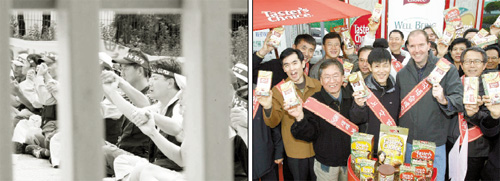Nestle Korea letting go of its turbulent past

Union members of Nestle Korea, left, protest in front of the plant in Cheongju in September 2003. At right, union head Park Sang-dae, third from left, and factory manager Gavin Steiner, fourth from left, promote Nestle products on the streets of Cheongju last Saturday. [JoongAng Ilbo]
In July of 2003, 500 union members of Nestle Korea’s factory in Cheongju, North Chungcheong province went on a 145-day strike, protesting company restructuring. Management responded by closing the company’s Seoul office and Cheongju plant, resulting in labor unrest so extreme that at Nestle headquarters in Switzerland, the dispute is still viewed as the “worst strike” in the history of Nestle.
At the time, some union members went to large discount stores and told consumers not to buy Nestle products that they had made.
Now, however, the union has changed its stance. On Saturday, in front of a large discount store in Cheongju, Park Sang-dae, head of Nestle’s labor union, stopped passers-by in the cold, offering hot coffee and cocoa.
With a banner that read “Nestle Korea ― where labor and management cooperate” slung over his shoulder, Mr. Park passed out the beverages, saying, “We’ve put our strengths together and we’re going to be reborn as a good local firm. Please watch us.”
Behind him was a large sign saying that Nestle Korea’s cooperating labor and management wishes everyone happy Lunar New Year. The 40-some participants at Saturday’s event were part of the extreme strike that took place in 2003.
It was the labor union’s idea to host the event. It wants to reshape the idea that the Nestle Korea company was always associated with strikes.
“Although the strike was a long time ago, a lot of locals still think that we’re on strike or that the factory has withdrawn,” Mr. Park said. In Cheongju, Nestle’s market share is the lowest among all regions in the country, reflecting a cold viewpoint of locals on the company.
Mr. Park said a feeling of crisis among employees prompted the union to change its mind. The aftermath of the 2003 strike was big. Coffee goods, which were mostly exports, could not meet deadlines because of the strike. Because of that, a lot of traders stopped doing business with Nestle Korea. A company that used to make operating profits of 20 billion won ($21.3 million) a year, saw deficits of 13 billion won that year.
Gavin Steiner, the new Swiss factory manager appointed in February of 2005, also played a large part in opening the minds of union members. He took photographs with workers at the job site and edited them into a film shown at the end of the year that also became a calendar. Last August, at Steiner’s proposal, employees’ children were invited to a drawing event hosted by the factory.
The new employee attitude showed up in the vote last December for a new union head, where Mr. Park, who advocated “cooperation,” was selected. He received 61-percent support, highest in the company’s labor union history. The new labor union invited the president to its general meeting last month. In turn, labor union members were invited to participate in the company’s marketing strategy meeting scheduled for next week.
By Park Hyun-young JoongAng Ilbo [wohn@joongang.co.kr]










with the Korea JoongAng Daily
To write comments, please log in to one of the accounts.
Standards Board Policy (0/250자)